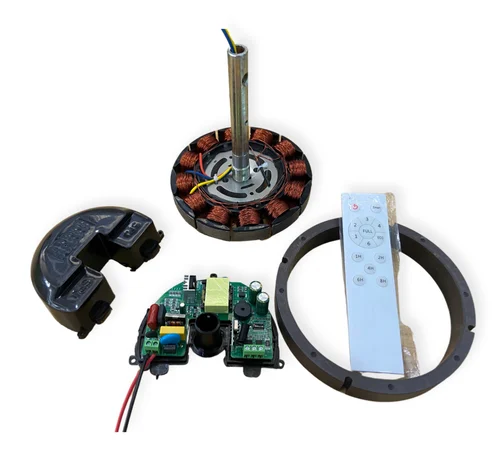
Bldc Ceiling Fan Parts
Intellifan is actually offering the best ceiling fan BLDC motor parts in the market to its clients. They have manufactured these products through the use of superior quality materials and the latest, state-of-the-art manufacturing processes to ensure that the products are long-lasting and efficient. The company has continuously sought the most recent technologically advanced systems available in the market regarding the production of ceiling fans with BLDC motors. This approach, accompanied by effective research and development, has led the company to produce innovative solutions ensuring more efficient, quiet, and energy-saving BLDC ceiling fans. The company offers a long list of BLDC ceiling fan parts to accommodate various needs and preferences. From high-performance motors, intelligent controllers, to stylish fan blades, their product list ensures that one can find the best mix to create an efficient cooling solution with utmost customization.
Intellifan’s BLDC ceiling fan parts are fully designed to be high on energy efficiency. These spare parts entail lesser electricity costs and a reduced carbon footprint since they consume less energy. Therefore, they are an eco-friendly choice for the eco-sensitive user. Most Intellifan BLDC ceiling fan spare parts come with remote-control systems and smart technology, allowing easy and flexible control for you to experience greater comfort and convenience. The BLDC ceiling fan parts by Intellifan have created a reputation for reliability and consistent performance. They have been designed for heavy usage so that you can keep them working without any problems for many years-thus a good investment.
BLDC ceiling fan parts industry By choosing Intellifan, you can be confident that you are investing in items that are not only efficient and long-lived but also contribute to a more sustainable and comfortable living space.
1. BLDC Motor
The heart of the ceiling fan, the BLDC motor, consists of several key components:
- Stator: It is the stationary component of a motor. Traditionally, this stator comprises windings in which electric current flows to produce a magnetic field.
- Rotor: Usually formed of permanent magnets that rotate. The position of a rotor inside a BLDC motor moves around the stator while the rotor has its position on the outside.
- Hall Sensors or Back EMF: are employed to sense the rotor position in the ability to obtain precise control over when the current is given to the stator windings.
2. Electronic Speed Controller (ESC)
This part controls the speed of the BLDC motor by altering the flow of currents. The ESC changes the DC power provided by the source supply to the proper phase and frequency demanded by the motor. The parts of an ESC consist of the following:
- Microcontroller: This is considered the brain of the ESC and processes input signals and varies its application to the motor.
- Power MOSFETs: They act as the voltage and current switches of the power supply to the motor windings in this design.
- Control Algorithms: which provide efficient and friction-free motion by altering both the phase as well as frequency of the power supplied to the motor, implemented in a microcontroller.
The blades are fitted onto the rotor and are charged with circulating air. Normally, aerodynamic blades of BLDC ceiling fans are incorporated in order to enhance its delivery and efficiency on AI.
4. Mounting Assembly
This includes the downrod, canopy and other mounting hardware to attach the fan on a ceiling. This is provided by a metal pipe, downrod which ensures the fan hangs at the appropriate height while the canopy covers the attachment to the ceiling for a neat appearance.
5. Remote Control or Wall Control Unit
BLDC fans often have a remote or wall-mounted version, so users find it very easy to have fast/hard turns, change speed, and sometimes even light if the fan integrates lights. Controls communicate with the ESC.
6. Capacitor
In some designs, a capacitor might be used for additional power factor correction to improve efficiency and performance.
7. Housing
It accommodates the motor and electronic parts to avoid direct exposure to dust and aesthetic appearance. It is designed such that it ensures good airflow as well as dissipates heat; hence, overheating is prevented.
8. Lights (Optional)
Many of the contemporary ceiling fans are equipped with built-in lights which can be of LED or of any other type, and such lights can be controlled by the same remote control or wall unit that is used to control the fan.
9. Ball Bearings
High-quality ball bearings ensure to allow for smooth as well as quiet operation. They reduce friction and wear which enhance the life span of the fan.
10. Cooling System
Some high-end BLDC motors come equipped with supplemental cooling systems such as vents or even heat sinks to keep the motor at optimal operating temperatures not overheating the motor and thereby increasing the motor’s lifespan.
Advantages of BLDC Ceiling Fans
- Energy Efficiency: BLDC fans consume up to 70 percent less power than the usual AC motor fans, thus making them energy efficient.
- Quiet Operation: The absence of brushes and the electronics control incorporated in BLDC fans mean they could operate relatively quietly indeed.
- Longevity: The motor lasts for a longer period because of less wear and tear as it does not have brushes.
- Better Speed Control: Another important advantage of BLDC fans is their more accurate control over speed while able to operate in a much broader range of speeds.
- Smart Features: BLDC fans contain integral additional features in most cases, which include a sleep timer, motion sensor, and compatibility with home automation systems
